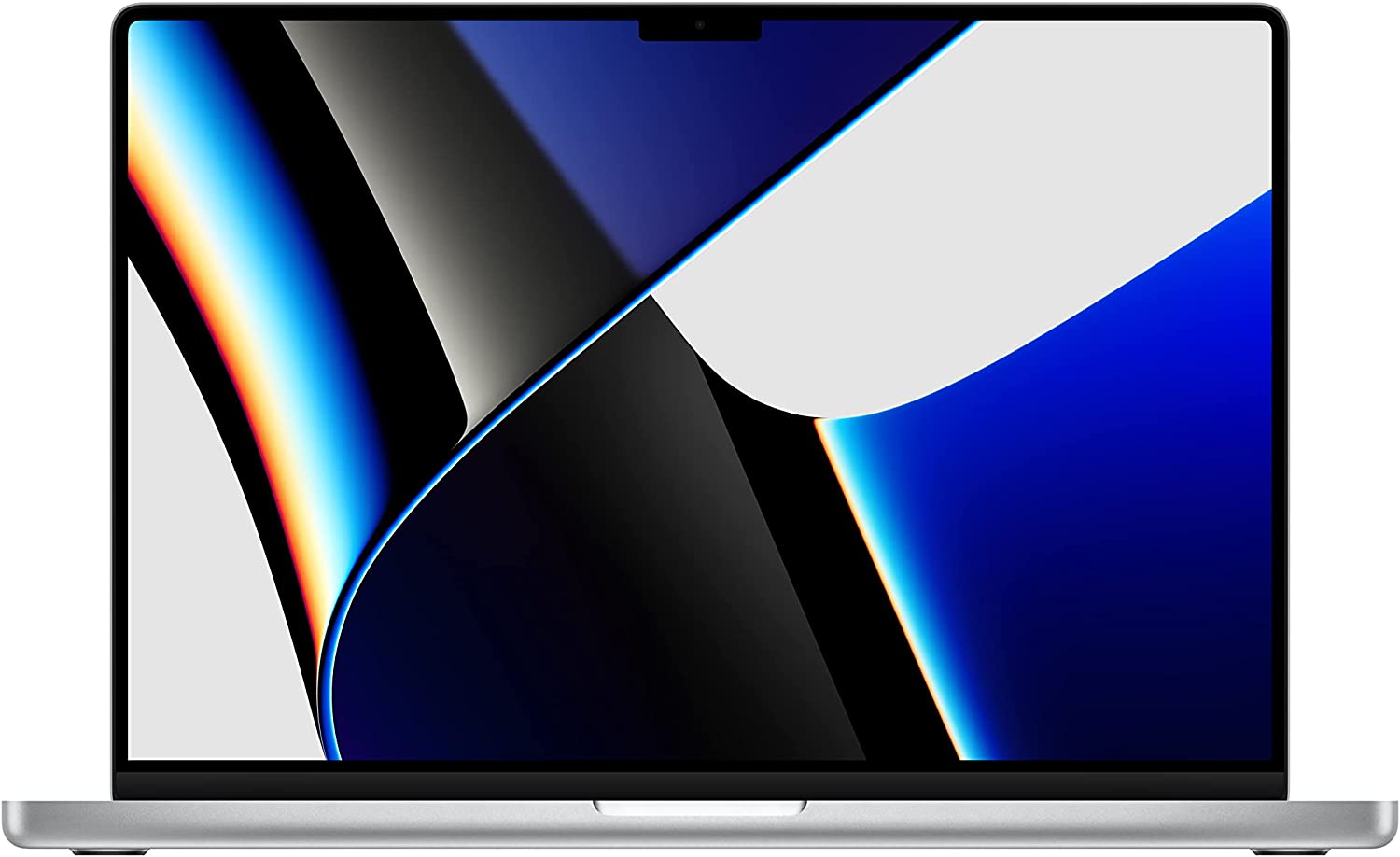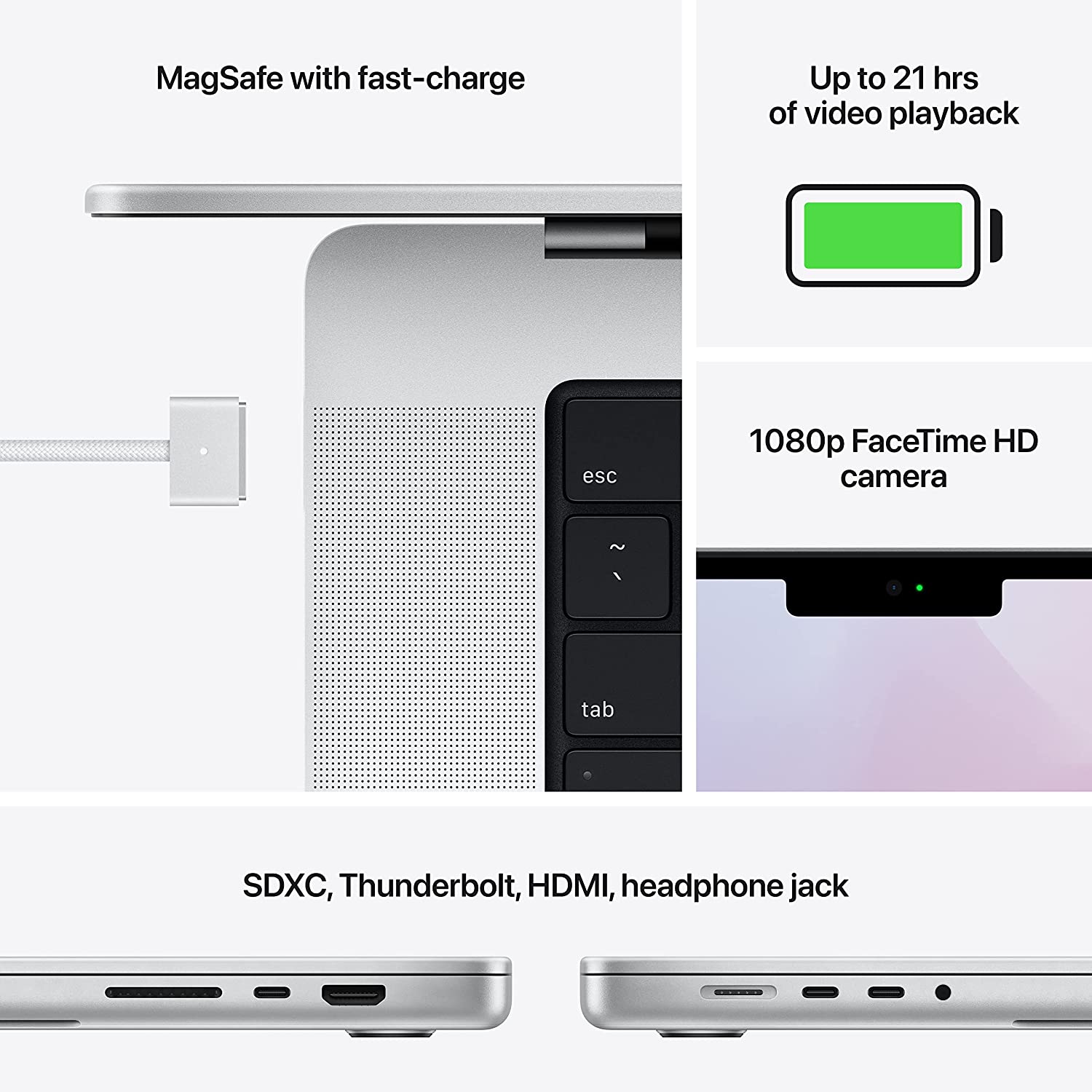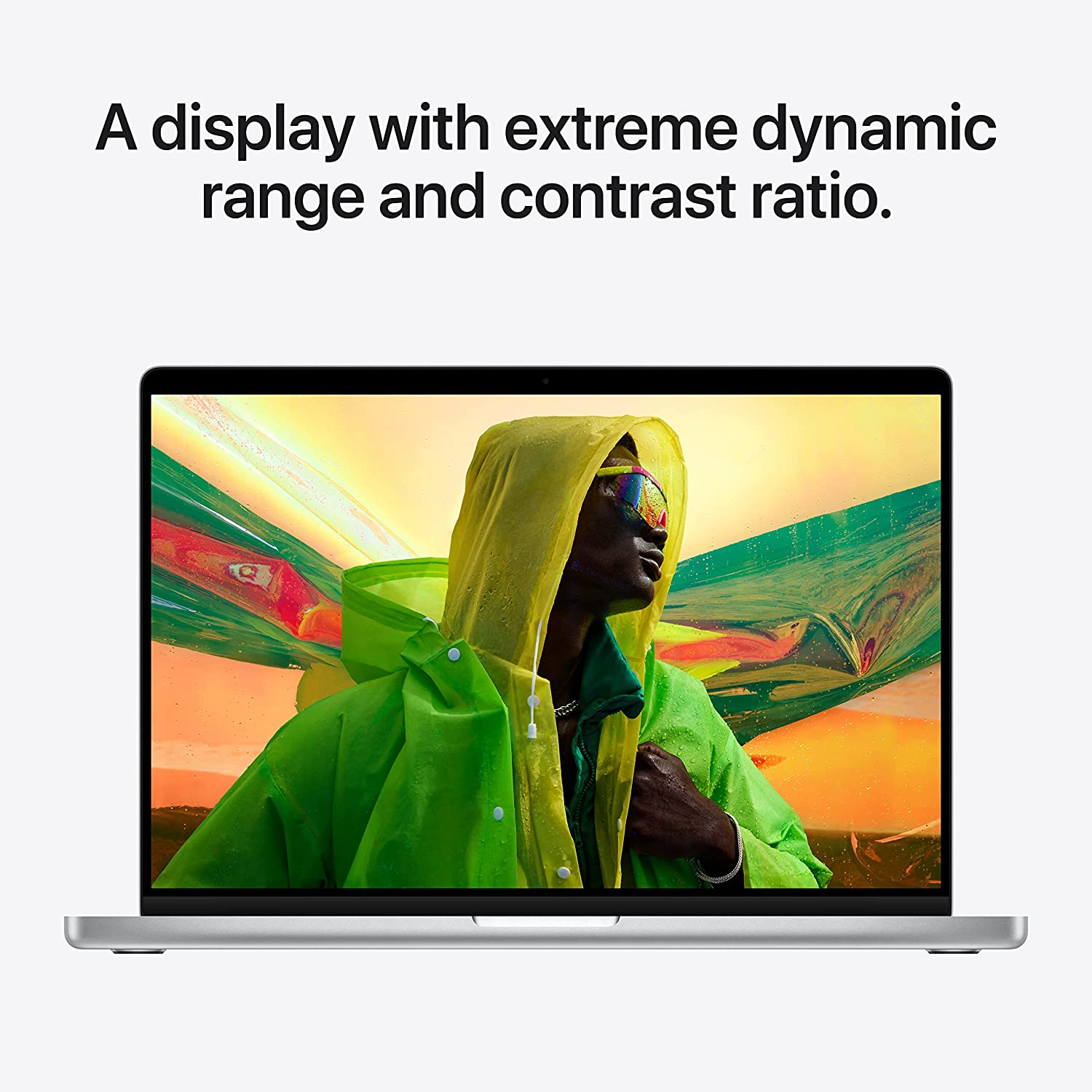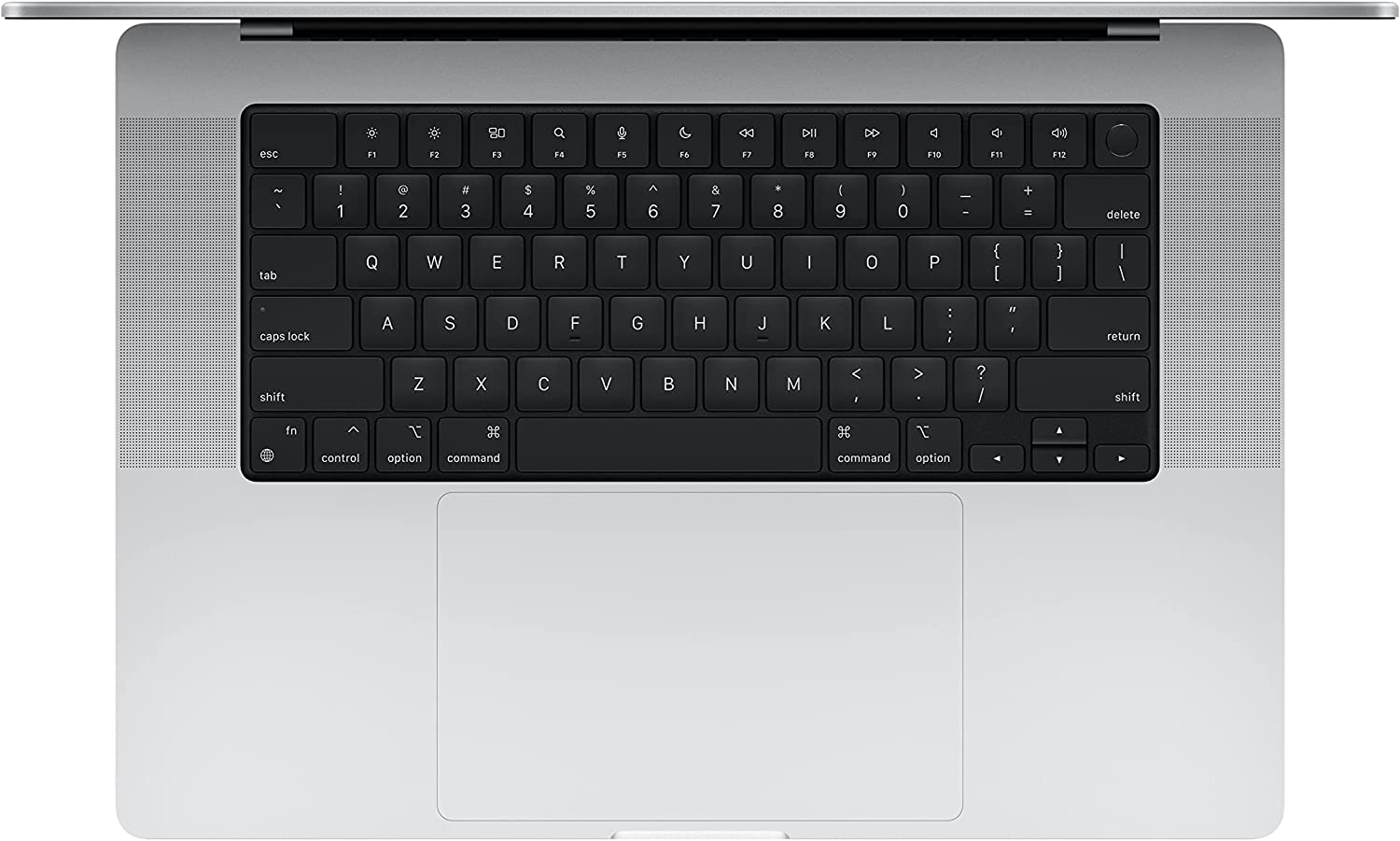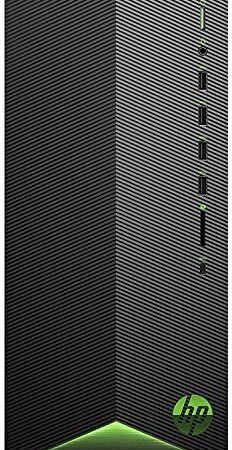Description
Product Details:
Apple M1 Pro or M1 Max chip for a massive leap in CPU, GPU, and machine learning performance. Up to 10-core CPU delivers up to 2x faster performance to fly through pro workflows quicker than ever
About this item
Up to 32-core GPU with up to 4x faster performance for graphics-intensive apps and games
16-core Neural Engine for up to 5x faster machine learning performance
Longer battery life, up to 21 hours
Up to 64GB of unified memory so everything you do is fast and fluid
Up to 8TB of superfast SSD storage launches apps and opens files in an instant
Technical Details
Apple MacBook Pro 16-inch with Touch ID
Display 16.2-inch (diagonal) mini-LED backlit Liquid Retina XDR display, 3456 by 2234 pixels with ProMotion technology for adaptive refresh rates up to 120Hz, and up to 1000 nits sustained (full-screen) brightness, 1600 nits peak brightness, True Tone technology, ProMotion technology for adaptive refresh rates up to 120Hz
Processor System on Chip (SoC) Apple M1 Pro chip; 10-core CPU with 8 performance cores and 2 efficiency cores; 16-core GPU;16-core Neural Engine;200GB/s memory bandwidth
Graphics and Video Support Apple 16-core GPU
Charging and Expansion Three Thunderbolt 4 (USB-C) ports with support for:Charging, DisplayPort Thunderbolt (up to 40 Gbps), USB 3.1 Gen 2 (up to 10 Gbps); HDMI port; SDXC card slot
Wireless Wi-Fi 802.11ax Wi-Fi 6 wireless networking; IEEE 802.11a/b/g/n compatible,Bluetooth 5.0 wireless technology
In the Box 16-inch MacBook Pro, USB-C to MagSafe 3 Cable (2 m), 140W USB-C Power Adapter
Height 0.66 inch (1.68 cm)
Width 14.01 inches (35.57 cm)
Depth 9.77 inches (24.81 cm)
Weight 4.7 pounds (2.1 kg)
Release Date 10/18/2021
Top reviews from the United States
-
Anon 5.0 out of 5 stars A laptop you can finally use on your lap Reviewed in the United States on October 29, 2021 Here are the temperature results for the new cool MacBooks compared to the old overheating intel ones. 91 degrees for the old one near the processor, and 74 degrees on the new ones. Both had been running for hours transferring files nonstop. Amazing. I have been editing video, transferring large files and not once have the fans kicked on. Makes me want to cry.
-
Sanpete TOP 1000 REVIEWER 5.0 out of 5 stars Great for work and some play Reviewed in the United States on November 4, 2021 Verified Purchase This is an unusually large advance over previous models, especially in raw computing power, but also in fun things like screen and headphone support. This Amazon listing has two different processors, the M1 Pro (listed as 16-Core GPU "style") and the M1 Max (32-Core GPU). I'll call one the Pro, the other the Max. I got the base Pro, but much of what I'll say applies to both, and I'll have some comments specifically about the Max too. (MBP below = MacBook Pro.) Amazon doesn't offer most of the options you can get, only the ones listed. For now (and probably later), that's the Pro with 16GB RAM and 512GB or 1TB SSD, or the Max with 32GB RAM and 1TB SSD. 3 versions total. Screen Brightness* and Happiness This screen can get up to 1600 nits brightness and can sustain full-screen brightness up to 1000. That's very impressive, as MBPs since 2016 have topped out at 500. *But the vast majority of the time, this screen will also top out at 500, because those other numbers are only for HDR (high dynamic range, what Apple calls XDR), i.e. some videos and some photos viewed in some programs. If you're browsing the internet, using productivity apps, or the like, those are almost all SDR (standard dynamic range). You'll be seeing them at the same brightness as with MBPs for the last five years. That said, the new screen is beautiful and bright in both HDR and SDR for most situations. For HDR, it puts out more color and brightness, and darker blacks - a million-to-one contrast ratio - with a wider range of light and color that has more pop and more detail in shadows and highlights. It can be dazzling or just more realistic. For SDR, it's much like before, still a gorgeous screen, with better contrast than before because of darker blacks. Has more pixels per inch (254, up from 226), and more pixels all over (3456 by 2234, up from 3072 by 1920). The aspect ratio remains 16:10 (not counting the top menu bar). ProMotion ProMotion is Apple's name for screen refresh rates that can go up to 120Hz, or lower to save processor/battery power when 120 isn't needed. This makes motion smoother, more natural. For now where ProMotion applies is limited. Most scrolling in browsing, including with Safari, still tops out at 60Hz. Which is fine for me, but it bothers some people, looks choppy to them. This could be changed with a software update. Bloom and Ghosts Bloom is when a bright spot on a dark background bleeds out past where it's supposed to be, a common issue with this kind of screen. I and most others think this screen handles it well (better than the iPad Pro), but it can still arise some. Ghosting is when a moving object leaves a noticeable trail of ghost images behind for a fraction of a second, one for each new frame until the old image fades. MBPs are notoriously mediocre at this kind of ghostbusting, and this screen is no exception. Expect the usual haunting, if you notice that kind of thing. PWM For those concerned (you mostly know who you are), there is PWM (pulse-width modulation) on the smaller 14" version of this screen, and so very likely on this one too, at a frequency of 14,880Hz at all brightness levels (measured by NotebookCheck). That's a very high frequency, considered well beyond what would cause trouble for the susceptible. The Notch As you can see in the main photo here, there's a black Notch at the top of the screen. There are no pixels there. The long-desired improved camera is there, and a mic array and light sensor (and maybe room for a Face ID system if they decide to make MBPs with that). As with the iPhone Notch, it's controversial. You can make the Notch disappear, or rather blend in, if you make the background up there black. It also disappears into the black bars when you view things like videos in full-screen mode. The cursor disappears into the Notch if you put it there. If an app has menu items that stretch there, they disappear too, but they'll still function normally if you put the (invisible) cursor on them. Desperate times call for desperate measures. Most apps won't have this trouble, but if you must, you can avoid menu items disappearing by using the "Scale to fit" function, which shrinks the entire screen work area a little to fit below the Notch. Makes it look like an old 15" if the background is black, like there are wide black bezels. (Google "Scale to fit below built-in camera" for full instructions and mockery.) There are also third-party apps, such as Bartender, to manage how items appear in the menu bar and keep them visible. Camera and Mics The new camera that, along with the thinner bezels, makes the Notch necessary, is 1080p, with an f/2 lens for good exposure in the shadows. Video looks noticeably better than before, though it can have a processed look. The three mics sound very clean and natural but with a little less bass than before to my ears, which is fine. Extra Screens You can use two external monitors with the Pro, down from four with previous models. They can be up to 6K @60Hz with a billion colors. The Max can still use four: three 6K and one 4K, all @60Hz etc. You can use 4K @120/144Hz HDR monitors too. You can run two from one port if you use the right kind of dock or daisy-chain. Headphone Oomph The new headphone jack has more power for high-impedance headphones. It automatically adjusts, so it won't overwhelm low-impedance phones. If the headphones have less than 150 ohms impedance, they get 1.25 volts RMS. If more, 3 volts. That might cause it to fail to provide enough power to some not-so-high-impedance headphones that still require extra power, such as planars. With my 2016 15" MBP, I've had to use a portable amp for my Beyerdynamic DT 1990 Pros (250 ohm), but now I can pretty well do without it, though sometimes only just. The volume on some sources is still not always what I wish I could make it. But now I can nearly achieve hearing loss with the intro to the guitar riff in "Money for Nothing." Which also sounds good, and healthier, a couple notches down. Among other headphones that have tested favorably with the new jack are the DT 990 Pros (250 ohm), and the Sennheiser HD650, 660S, 6XX, and HD800 (150 to 300 ohm). One report says the planar Hifiman HE4XXs (35 ohm planar) sound good, but most planars tested are said to need more power. The Audeze LCD-2Cs are reported to sound good enough, though not their best. The LCD-3s and Hifiman Sundaras and Aryas are said to be underpowered. For my usual regular-impedance phones, Cleer Flow IIs (16 ohm), the wired volume is a little louder than before, though still not always the earsplitting barrage I want for some sources. Maybe for the best. Quality iems (in-ear monitors) that require especially clean input, but not too much, reportedly sound good, including Andromedas and Moondrop Starfields. Speakers They're improved from the already laptop-leading speakers from earlier MBPs, with a fuller sound and decent kick, amazingly good for when nothing with a 3" woofer is around. Apple mysteriously says the 14" M1 has the same speaker system, but looking inside both machines shows the speakers in the 16" are bigger - both "subs" and tweeters - and located differently, with the subs in the front corners on this one. The 16" has fuller bass (such as it is). Heat and Noise There isn't any. None with my typical use, at least. If you push it hard, it can get warm, but not as hot as my 2016 15". Which makes sense, as this has a larger enclosure, bigger fans, larger, better heat sinks, and more power-efficient processors. The fans don't have to spin up as much to do the same amount of cooling, so it's noticeably quieter even when it does heat up, rarely makes any noise at all. The 16" Max comes with a larger heat sink than the 16" Pro, so likely runs a little cooler and quieter sometimes, though the Max might get hotter when it uses a lot of that extra power. Keyboard Very quiet, much like the older Mac laptop keyboards, not the butterfly ones from 2015-19, but the rest. Maybe less travel in the keys than some of those, but plenty for me. I miss the touch bar sliders for fine control of some functions, but you can still use sliders via the Control Center, the icon next to the date on the screen's top menu bar. That's also where control of the keyboard backlight is, no more control for it on the keyboard. Touchpad The best available by far, responsive and large so you can carry the cursor over a large area with more control. For clicks, it's great. For taps, which I turn off, it's not as great, according to those who prefer that - appears to be a software issue. Ports There's one less Thunderbolt/USB-C port than before, but 50% more bandwidth (3 controllers instead of 2). The HDMI is 2.0, can drive up to 4K HDR @60Hz. The SD card reader is shallow, so the cards stick out. There might be room for a flush micro-SD adapter. I only have cards up to 64GB, which work fine. Some people have had trouble reading some cards, so it may be finicky. Battery Life I usually keep plugged in, but the reviews I've seen that cover battery life tests typically say it's the longest of any similar machine they've tested, including PCs. Reports of battery life for office work, browsing, watching videos, and so on generally range from 10 to 16 hours, sometimes more. It can go unusually long with heavy use too, 5 hours or more of video work, for example. Max Tech did 10 benchmark and stress tests with it in a couple hours, some maxing out the CPU or GPU for up to ten minutes, and it still had 36% left. At normal settings, there's no performance hit until you get down to 3%; until then you can process or game at full tilt. There's a low-power mode that extends battery life by limiting performance, lowering screen brightness, etc. The Max also has a high-power mode, but it seems to only ramp up the fans sooner to help cooling. Apple's description and tests in reviews indicate it doesn't affect performance in any direct way. The Max has tended to have a little less battery life than the Pro in reviews. The only good tests I've seen that compared directly either found negligible differences or up to 15% less battery life for the Max. (Other tests haven't been well controlled.) You can quick charge to 50% in a half-hour. The new power brick is 45% more powerful than before, and maybe 30% larger lengthwise, still small for what it does. You can charge at lower speed with smaller bricks (not included) via the USB-C ports. Size and Weight It's noticeably heavier than before, about 5 ounces over the previous 16", and not quite as sleek, but it's sleeker than I was expecting from the photos. Repairability Ha ha! But really, it's better than it was. Battery modules now have pull tabs so they can be more easily replaced. The screen can be replaced more easily, but if Apple doesn't do it you lose True Tone (which I don't want anyway). The headphone, Thunderbolt and MagSafe ports can be replaced without replacing the logic board. Now rates a 4/10 from iFixit for repairability, up from 1/10 for the previous model. Compatibility Comes with Rosetta 2, which enables M1 Macs to use programs written for Intel Macs, and usually works very well. There's no more Boot Camp, so to run Windows or Windows programs you have to use third-party software like Parallels, which runs Windows by emulating a Windows machine (and requires a Windows license), or Crossover, which modifies Windows programs to run on Macs. Which works best, or at all, depends on the program. Gaming WoW *mostly* runs 50 to 120fps at high settings and resolution, depending on the location. Some places can't even manage 50 at those settings, though, but do OK at more compromised settings. Baldur's Gate 3, Diablo III, CS:GO and several others can run at 60-100fps or better at good settings. You can play Windows games via Parallels or Crossover. They generally don't run as well, but some do fine. Most games, including native ones, run quite a bit better on the Max, with up to 2x the fps. Final Fantasy XIV is hit and miss at good settings even with the Max. Gaming isn't usually hot or noisy, can get warmer with light fans for the games that aren't running natively. And there's no noticeable performance hit for gaming on battery. Work I have to mention the less fun part: how well this does things you might have to do at work. It does almost all of it better than before, much of it way better. Here's how it compares according to actual test results from numerous sources with Xcode, Logic Pro, Lightroom, Blender, Final Cut Pro, Premiere Pro, and so on. The range of comparison depends on what the task is. Previous base MBP 16" (Intel i7 AMD 5300): The Pro is 60% to several times faster. Previous top-spec'd MBP (i9 5600M): The Pro is about the same to 2 or 3 times faster. Regular M1 machines (not M1 Pro or Max): The Pro is about the same to several times faster. The 14" M1 Pro with same specs: The same, though the 16" has the bigger battery and heat removal system, so it fares better in those ways. Windows laptop work stations: This is complicated, but the Pro can thrash most Windows laptops in most intensive work-related apps. It lines up very roughly with machines with a good i7/i9 and an RTX 3070, but generally can't keep up with the RTX 3080. The Pro uses a fraction of the power, and so only produces a fraction of the heat and noise, if any. And lasts and performs much better on battery. Pro vs Max The Max is about the same to twice as fast as the Pro, mostly between those extremes. The CPU is much the same, but the GPU is double the cores, so the main advantage is in graphics-heavy work. Besides the GPU cores, the Max has twice the bandwidth for memory transfer, two hardware video encode engines instead of one, and some extra cooling capacity. If you're already successfully using a Mac laptop, you don't *need* the Max, since the Pro is already better than what you have. But that doesn't mean you can't benefit from the Max's extra power if you have the money. For intensive video editing, massive photo editing, or better gaming (though cheaper Windows machines will play most games better), the Max has real advantages. To confuse things a little more, Apple (but not Amazon currently) also offers a demi-Max with a 24-core GPU, halfway between the Pro's 16 and the Max's 32. It's a cheaper way to get the extra bandwidth, video encoder, and cooling advantages of the Max. Tests show that in graphics-intensive tasks it operates roughly midway between the Pro and 32-core Max, often more than half, as expected. Warranties This comes with a one-year limited warranty against manufacturing defects that includes free phone support for the first 90 days. If you want to also cover accidental damage (with deductibles) and extend the regular warranty and free tech support to 3 years, you can buy AppleCare+ from Amazon (link embedded) or Apple. You get 60 days from purchase to buy it, but coverage for accidents doesn't start until you do. (I always self-insure when I can, so I didn't get it.) Decals Last and least, this comes with two black Apple decals, the sign of true professional Apple equipment. Read more 413 people found this helpful
-
Joseph Thomas 5.0 out of 5 stars Insanely fast. Reviewed in the United States on October 31, 2021 Verified Purchase This laptop is unbelievably fast. Between the screen, battery life, and performance, this laptop is head and shoulders better than any competition. 129 people found this helpful
Summary
Apple M1 Pro or M1 Max chip for a massive leap in CPU, GPU, and machine learning performance. Up to 10-core CPU delivers up to 2x faster performance to fly through pro workflows quicker than ever

